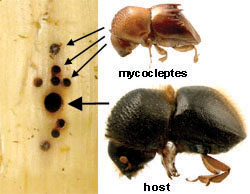Stealing Fungus

Fig: Multiple entrance holes of fungus-stealing Diuncus duodecimspinatus (top, smaller holes), drilled around the much larger entrance tunnel of Hadrodemius globus. Photo J.H.
On many field collecting trips, we noticed that several unusual species of ambrosia beetles always drill their tunnels next to a larger gallery of another species. It turned out that the smaller beetles evolved a strategy of stealing fungus. Instead of carrying around their own symbiont, having to find a good breeding tree, and risking a failure of their fungus garden establishment, they figured out how to find already established galleries of other ambrosia beetles. By drilling around these, they let the fungal symbiont of the larger species enter their gallery and form a fungus garden. We have confirmed this by comparing the fungal communities in many galleries of both the fungus thieves and the parasitized beetles. We also discovered that the most highly-evolved fungal thieves (the xyleborine genus Diuncus) lost their mycangia! Apparently, they don’t need them any more.
Now that we know what to look for, we at the UF Forest Entomology Lab have found many different species of ambrosia beetles practicing fungus theft. It evolved independently at least four times on several continents.
For more details see: Hulcr, J. & Cognato, A.I. (2010) Repeated evolution of crop theft in fungus-farming ambrosia beetles. Evolution, 64, 3205-3212.
